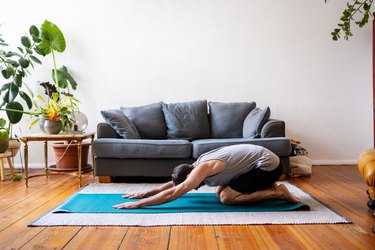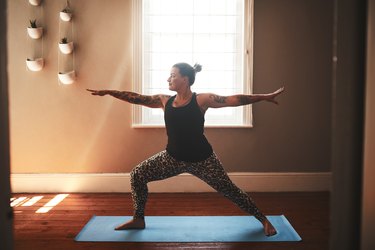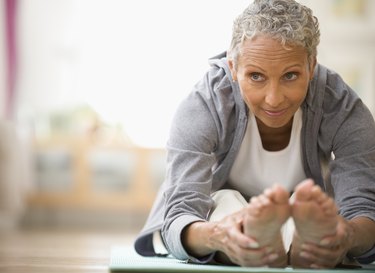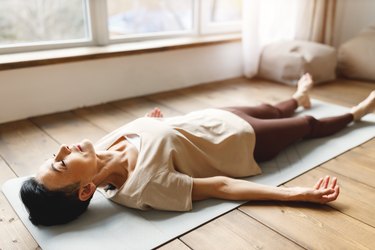
In yoga, focusing on your form while you're in each pose is important, as well as staying aware of your body and keeping your breath consistent. But here's one more factor to throw in the mix: the length of your hold.
There's no universal rule for how long you should hold a yoga pose — like holding a pose for three breaths or five seconds, for example — because the length of the hold depends on what type of yoga you're doing and what your goals might be.
Video of the Day
Video of the Day
Here's a quick guide on the purpose of each timeframe, according to yoga teachers.
Short Holds: Vinyasa, Power Yoga
Yoga styles that involve short holds for their poses tend to emphasize a technique known as "one breath, one movement."
In a sun salutation, for instance, you inhale as you stand in mountain pose, exhale to forward fold, inhale in a halfway lift, exhale to plant your hands and step back to plank and so on. You can think of it like a metronome, Lindsay Payne, RYT-500, yoga leader at Life Time in Edina, Minnesota, tells LIVESTRONG.com.
"With this style, like a vinyasa flow, a practitioner uses that internal cadence of their breathing to move in and out of postures," she says. "One can feel how organically an inhale creates lift, opening and expansion, while just as naturally one's exhales encourage lowering, grounding, twisting and folding."
You can use this type of flow to make a practice slower and more reflective — with deeper breaths — or to get more aerobic through a faster flow.
Medium-Length Holds: Iyengar, Hatha, Ashtanga
There are numerous styles of yoga that fall into the Goldilocks area of not too fast and not too slow. These can be Hatha, Iyengar, some forms of hot yoga and Ashtanga.
In these classes, you tend to hold poses for about five breaths each, Payne says, and that gives you time to settle in and adjust a pose, but then transition out again at a steady pace.
This length of hold tends to be beneficial for those who want a challenge but also may be new to the practice, Jessica Schatz, RYT, a yoga teacher based in Los Angeles, tells LIVESTRONG.com.
She says a faster practice, like power yoga or a fast vinyasa flow, can feel overwhelming if you don't know your alignment in every pose or you're trying to connect your breath to your movement.
"The meditative nature of yoga and the way you move is all about your breath, so the length of your hold comes down to how that feels in your body," she says.
Long Holds: Yin, Restorative
The two main types of yoga that feature long holds are Yin and restorative, and they might look similar, but they each have different goals.
Restorative yoga is usually done with numerous props, like blankets and bolsters, that get your body into a certain position where you can rest for 5 to 10 minutes per pose. Although there's passive stretching, restyorative yoga doesn't require much effort, you're just sinking into the supported pose.
Although there can be some prop use in Yin yoga, this type of practice involves more active holds, and it creates a beneficial type of stress in your body, Payne says.
"This is a slow, meditative practice designed to mindfully stress your body's connective tissues as you breathe into the ever-changing sensations that arise in long-held poses," she says.
"It takes a minimum of 2 minutes for this process to take place, so holding a Yin-style posture for 5 minutes or more is ideal so your body can soften around the sensations that arise."
Yin poses can be challenging — for example, frog pose is designed to stretch the connective tissue in the groin, and it gets intense — but Payne says this type of "positive stress" ultimately leads to a stronger, flexible and more balanced body.
The Bottom Line: It's Up to You
Although some of the examples above mention specific yoga styles, the fact is there's a great deal of variability from one class to another, or even in one section of a class compared to the rest.
Some Iyengar teachers might offer shorter holds, for example, in favor of more repetition of getting into and out of the same pose, and then follow that with a single pose held for a longer time.
If you're doing your own sequences at home, or even if you're in person at a class, remember your practice is your practice. If you want to hang out in butterfly pose a little longer, go for it. If you want to move through the classic vinyasa of plank to upward-facing dog to downward-facing dog at your own pace and with your own breath, that's up to you.
Like many other variables in yoga, playing around with different options can help you personalize the practice in a way that feels nourishing instead of rushed.


